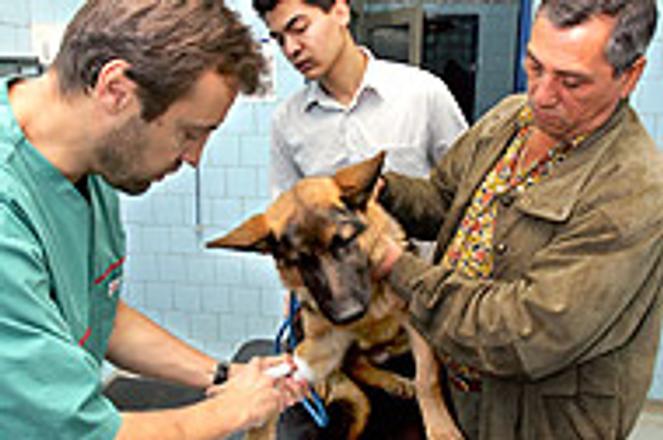The UVM hopes its new clinic set-up will help train better vets.
photo: Sme - Pavol Funtál
YOUNG veterinary doctoral students need good clinical teaching to get them ready for practice, says Emil Pilipčinec, the rector of Slovakia's only veterinary university - the University of Veterinary Medicine in Košice (UVM).
"Our experience says that clinical teaching, the equipment in clinical workstations and the range and quality of the clinical services provided by them are a showcase and source of pride for every veterinary school in the world," he said.
So UVM came up with a new organisational structure, which it introduced on September 1. It includes five clinics and four independent workstations across 11 departments.
The new structure of clinics is based on species, with the five clinics specialising in small animals, horses, ruminants (for example, cows, goats and sheep), pigs, and birds, exotic and wild animals.
"With this new structure, we expect not only to improve education and research relating to certain target species or groups of animals, but also to create better conditions for providing complex preventative and therapeutic services," Pilipčinec told The Slovak Spectator.
This could also help the university's chances of getting EU structural funds, he added.
Even before the reorganisation, UVM was a place where internationally-recognised research was carried out, especially in the biomedical microbiology and immunology laboratory, and the national reference laboratory for pesticides.
These laboratories took part in international projects financed by EU funding for supporting research and development on a European level, Pilipčinec said.
The EU is also involved with UVM in other aspects, he explained. Veterinary medicine is one of the so-called regulated professions, which means that the education (and the practice) has to meet certain EU standards. That means the quality and effectiveness of the university's work is evaluated not only on the university and national levels, but also on the international level.
This evaluation is performed by the Joint Education Committee, based in Brussels. The committee has already evaluated the quality of UVM's education and research twice - in 1997 and 2006.
Even though UVM meets the EU's strict evaluation conditions, Pilipčinec says there is still room for improvement, according to the evaluation committee's recom-mendations.
"These are not always easy, simple and fast solutions, because they don't just depend on administrative decisions from the university's management," Pilipčinec told The Slovak Spectator. "They also require significant investments into reconstructions, or constructing new buildings."
UVM teaches future veterinary doctors in general veterinary medicine (the only programme also taught in English) and hygiene of food. It also offers bachelor programmes in cynology and food safety. New this year is a Master's programme in pharmacy.
Thanks to good evaluation results, the UVM's general veterinary medicine diploma is valid in all EU countries and Israel. This is the main reason why foreign students are interested in studying veterinary medicine in Košice, Pilipčinec said.
Foreign students study at UVM as part of the Erasmus and CEEPUS exchange programmes and bilateral cultural agreements.
Most international students - 14 percent out of the students at the university - stay at UVM for the entire general veterinary medicine study programme, Pilipčinec said. This year there are 184 students doing this programme in English: 90 of them from Israel and the rest from different European countries such as Norway, Sweden, England, Ireland and others.
"The admittance criteria for foreign students are the same as for Slovaks, which is the results of admittance tests," Pilipčinec said.
Foreign students have to pay tuition fees. They often use various national resources from their home countries.
"From our point of view, Norway has the best national system of support for students studying abroad," Pilipčinec said.
The reasons for foreign students to study veterinary medicine in Slovakia vary from case to case. According to the Slovak Sme daily, it is difficult to get a place at the only veterinary school in Israel, where 1,000 applicants compete for 30 places. Financial reasons can also influence students' choices.
"At home it would cost me $15,000 (Sk696,400 or €21,000) per year. Here it is $7,000 (Sk158,500 or €4,800)," David Jackson from England told Sme.
With programmes taught in English, studying in Slovakia can be a better financial alternative. And international students are a source of extra income for UVM, so being able to invite more students from abroad would help the school. The university is planning to offer its cynology and pharmacy programmes in English.
"We can only increase the number of foreign students to the level where we can still make sure the quality of the veterinary teaching meets the requirements of the EU directive," Pilipčinec said.
University of Veterinary Medicine in Košice
Founded:1949
Organisational structure:
11 departments, 5 clinics and 4 independent workstations
Rector: Emil Pilipčinec
Website: www.uvm.sk



